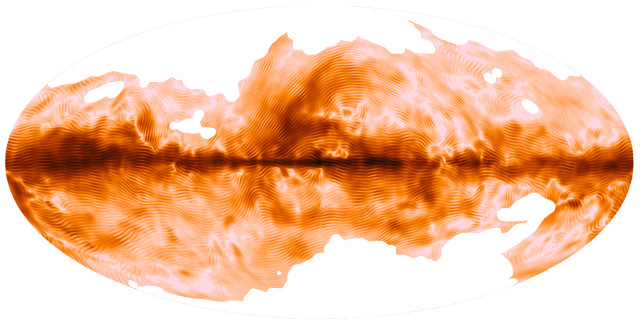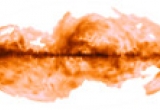Planck takes the magnetic fingerprint of our Galaxy
Our Galaxy’s magnetic field is revealed in a new image from ESA’s Planck satellite. This image was compiled from the first all-sky observations of ‘polarised’ light emitted by interstellar dust in the Milky Way.
Light is a very familiar form of energy and yet some of its properties are all but hidden to everyday human experience. One of these – polarisation – carries a wealth of information about what happened along a light ray’s path, and can be exploited by astronomers. In space, the light emitted by stars, gas and dust can also be polarised in various ways. By measuring the amount of polarisation in this light, astronomers can study the physical processes that caused the polarisation. In particular, polarisation may reveal the existence and properties of magnetic fields in the medium light has travelled through.
The map presented here was obtained using detectors on the Planck ESA satellite, which has mapped the whole sky between 2009 and 2012 in nine frequencies in the submillimetre, far infrared, and radio ranges. The data from the High Frequency Instrument (HFI) were essential for this result. This instrument has been designed and built under IAS responsibility, with funding from CNES and CNRS.
Analysing the polarization data from Planck is a major research axis for the Interstellar Matter and Cosmology group at IAS, with funding from the MISTIC ERC, within the Planck consortium. The IAS team wishes to use the polarisation of emission from interstellar dust to describe the interaction between the magnetic field, turbulence, and the structure of the interstellar medium. This work relies on the comparison between data and MHD simulations of interstellar clouds. The team also develops a physics-based modelisation of the polarisation of emission from dust.

The magnetic field of the Milky Way, seen by the Planck satellite, in the 353 GHz channel of the HFI instrument. The dark regions correspond to a stronger polarised emission, and the striations indicate the direction of the magnetic field, projected on the plane of sky. Credits : ESA - collaboration Planck
Swirls, loops and arches in this new image trace the structure of the magnetic field in our home galaxy, the Milky Way. The dark band running horizontally across the centre corresponds to the Galactic Plane. Here, the polarisation reveals a regular pattern on large scales, which is due to the magnetic field lines being predominantly parallel to the plane of the Milky Way.
The data also reveal variations of the polarisation direction within nearby clouds of gas and dust. This can be seen in the tangled features above and below the plane, where the local magnetic field is particularly disorganised.
From galactic to cosmological polarisation
The brightness of the CMB has already been mapped by Planck in unprecedented detail and scientists are now scrutinising the data to measure the polarisation of this light. This is one of the main goals of the Planck mission, because it could provide evidence for primordial gravitational waves generated by inflation, immediately after the birth of the Universe.
In March 2014, scientists from the BICEP2 collaboration claimed the first detection of such a signal in data collected using a ground-based telescope observing a patch of the sky at a single microwave frequency. Critically, the claim relies on the assumption that foreground polarised emissions are almost negligible in this region.
Later this year, scientists from the Planck collaboration will release data based on Planck’s observations of polarised light covering the entire sky at seven different frequencies. The multiple frequency data should allow astronomers to separate with great confidence any possible foreground contamination from the tenuous primordial polarised signal. This will enable a much more detailed investigation of the early history of the cosmos, from the accelerated expansion when the Universe was much less than one second old to the period when the first stars were born, several hundred million years later.
Contacts at IAS:
- François Boulanger (polarisation): francois.boulanger @ ias.u-psud.fr
- Jean-Loup Puget (Planck): jean-loup.puget @ ias.u-psud.fr
Links:
- ESA press release
- The 4 first papers on galactic polarisation, submitted to Astronomy & Astrophysics:
- Planck intermediate results. XIX. An overview of the polarized thermal emission from Galactic dust
- Planck intermediate results. XX. Comparison of polarized thermal emission from Galactic dust with simulations of MHD turbulence
- Planck intermediate results. XXI. Comparison of polarized thermal emission from Galactic dust at 353 GHz with optical interstellar polarization
- Planck intermediate results. XXII. Frequency dependence of thermal emission from Galactic dust in intensity and polarization




